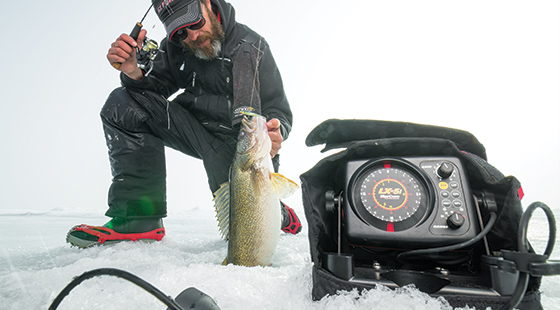Bad things can happen to great products — even MarCum®s. That’s the bad news. The good news is you can prevent most of the most-common flasher foul-ups.
For starters, never use your transducer to chip or knock ice out of a hole. Seems like a no-brainer, but you’d be surprised.
Most flasher failure is caused by an old battery or damaged transducer or cable.
“Only unwind as much cable as you need to position your transducer just below the bottom of the ice sheet,” Ice Force Pro Angler Tony Boshold says. “Otherwise, as you’re hole hopping, your transducer will be banging around too much, and that can cause damage.”
Prevent problems using just enough cable to get the job done.
“Most of the time, a couple inches below the ice is all you need,” Boshold says. “That’s plenty far into the water to find fish, and short enough to move easily from hole to hole and pull out of the way quickly when landing a fish.”
If you’re fishing with braided line, it’s especially important to shorten your transducer cable. “Because braid is abrasive, it can saw into your transducer cord,” Boshold explains. “After a few times of that happening, wires can be exposed and then you’ve got problems.”
Battery Maintenance
Another unforced error you can prevent is a dead battery. Remember to charge your battery before you hit the ice for the first time. And if it’s been a few years since you bought last bought your battery, it might be time to replace it.
“In your excitement to get on the early-ice bite — watching the weather, looking at maps, stocking up on baits, hooks and line — don’t forget the basics,” Tony Boshold says. “A dead battery — or one that poops out an hour or two into your day, because it doesn’t hold a charge like once it used to could — can make all your other preparation moot.”
All re-chargeable batteries require regular maintenance to preserve longevity. And regardless of manufacturer, no system will operate well with a weak or dead battery.
“And even if you bought something new last year, you could still have an issue at the start of this season,” Boshold explains. “That unit sat in the store in its box for who-knows-long before you brought it home.”
The vast majority of customer-service calls to MarCum Technologies are battery related.
“During the winter, hardly a day goes by without a unit coming in here for service that works perfectly; the only thing wrong with it was a weak or dead battery,” says MarCum Brand Manager Jon Marshall. “So before shipping your flasher back for repairs, please check – and then double check! – that the problem was not because your battery was weak or dead.”
If your flasher is exhibiting any of these symptoms, a weak battery is the likely culprit:
• Unit will not turn on
• Unit turns on, motor spins, but there are no lights
• Unit turns on, but only works for a short time
• Unit will not mark bottom or fish, with transducer clicking
To test your battery, you can power a MarCum flasher off any 12 volt battery, including one from your boat or truck. Simply touch the red and black to the red and black to see if your unit is working.
The following routine maintenance will help ensure optimum performance from your ice electronics:
• Regularly run your battery out of juice and then re-charge it.
• If your system comes with an automatic charger (most do), charge your battery after every use.
• Store batteries at room temperature. Big temperature swings in an un-insulated and un-heated garage will reduce a battery’s life.
• Top off your battery in the off-season. Charge it once a month during long periods of inactivity (especially over the spring and summer).
Might Be Time To Buy A New Battery
Most of the 12-volt batteries used in ice-fishing electronics last about three years. Consider buying a back-up if you’re close to that milestone.
“A back-up battery is cheap insurance against a bust out there on the ice” Boshold says. “And avoid the temptation of a bargain-bin battery. Sales are usually used to move out old stock.”
Be sure to get a sealed lead-acid battery. All common brands of 12-volt batteries are sold in standard dimensions that will fit inside your MarCum soft-pack. They come in 7, 8, and 9-amp versions. The higher the amperage, the longer run-time.
For most anglers, a 7-amp battery will cover an entire day on the ice. For extended use and longer periods without a re-charge, consider a 9 amp, which typically costs twice as much as a 7 amp.
